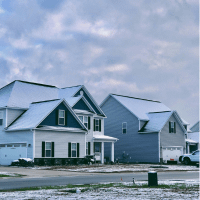Introduction
Understanding home appraisals is not just important; it’s crucial for buyers and sellers in the real estate market. These evaluations have a significant impact on mortgage transactions and property values. Appraisals are often set at the purchase contract price, which can lead to information loss and affect the accuracy of property valuation. Moreover, racial inequalities in appraisals contribute to broader socio-economic disparities. Here are the key aspects to consider:
Appraisal Practices and Information Loss
Home appraisals are often conducted at the price specified in the purchase contract, reflecting a notable trend in the real estate market. Research indicates that approximately 30% of appraisals align precisely with the contract price, while a smaller fraction, less than 10%, results in values that fall below the agreed-upon amount. This pattern suggests a solid adherence to the terms outlined in purchase agreements, which can be attributed to various factors within the mortgage lending structure. The motivations of appraisers and lenders play a significant role in this dynamic. Appraisers may feel pressured to provide valuations that satisfy lenders’ expectations, aligning their assessments with the purchase price to avoid tension or complications in the lending process. This tendency potentially diminishes the depth of insights appraisals can provide regarding market conditions and default risks associated with properties.
Furthermore, relying on appraisals within this framework can result in a critical information gap concerning the default risk assessment. While appraisals offer some level of insight into property value, they often do not capture the full spectrum of market dynamics or economic indicators that can affect a borrower’s ability to fulfil mortgage obligations. In contrast, automated valuation models (AVMs), which utilise broader data points and analytical techniques, tend to provide more robust evaluations for understanding default risk. Despite their limitations, appraisals still hold value in specific scenarios. For instance, when an appraisal reveals a property value below the purchase contract price, it may give borrowers leverage to renegotiate the terms of their purchase, potentially leading to a more favourable financial outcome. Thus, while appraisals serve essential functions in the transaction process, their efficacy in measuring default risk is often overshadowed by the capabilities of more advanced valuation methodologies.
Racial Inequality in Appraisals
A recent analysis of the Uniform Appraisal Dataset (UAD) reveals a troubling pattern of significant racial inequality in property appraisals. The data indicates that neighbourhoods predominantly populated by White residents are consistently appraised at higher values than those predominantly inhabited by communities of colour. This systematic valuation bias underscores longstanding disparities in how properties are assessed about their racial demographics, suggesting a relentless trend that favours predominantly White neighbourhoods over their non-White counterparts.
Worryingly, this disparity in appraised values has not remained stagnant; instead, it has intensified dramatically, with a reported increase of 75% over the past ten years. This escalation has been further exacerbated by the effects of the COVID-19 pandemic and the economic policies enacted in response to it. The pandemic has disrupted various sectors and influenced housing markets in unforeseen ways, which has disproportionately affected communities of colour, revealing the vulnerabilities within these populations and their real estate holdings.
The ramifications of such inequalities extend far beyond mere property values. They contribute to persistent racial wealth gaps that have hindered economic mobility for generations. The disparities in appraised values are not just numbers; they have tangible effects on wealth accumulation, leading to unequal access to resources that can improve the quality of life. Additionally, these inequalities propagate residential segregation, thereby limiting opportunities for individuals and families in communities of colour. This segregation has broader socio-economic implications, negatively impacting critical areas such as health, income, and educational attainment. Therefore, the findings from the UAD represent a significant concern that requires urgent and immediate attention, as they reveal deep-seated inequalities that continue to shape the socio-economic landscape in profound and often detrimental ways.
The Role of Appraisals in Mortgage Transactions
Appraisals are not just a part of mortgage transactions; they are essential. They play a significant role in determining various financial metrics, including loan-to-value ratios and mortgage insurance rates. According to findings by Calem et al. in 2018 and 2017, the appraisal process directly influences how lenders assess the value of a property relative to the amount of money being borrowed. This valuation is crucial because it dictates the terms and conditions of the mortgage, ultimately impacting the affordability and accessibility of home financing for borrowers.
In particular, at specific thresholds known as loan-to-value (LTV) boundaries, the implications of appraisals become even more pronounced. These boundaries indicate levels at which the risk associated with lending increases, prompting lenders to raise mortgage insurance rates as a precautionary measure. When appraisals occur at these critical points, they tend to align more closely with the contract price of the financed property. This alignment can create a scenario where inflated valuations are matched to the sale price, inadvertently leading to a rise in default rates. The correlation identified by Calem et al. 2018 and 2017 suggests that as appraisals and contract prices converge at these boundaries, the likelihood of borrowers defaulting on their loans may increase due to overvaluation and the ensuing financial strain it places on them. Understanding these dynamics is essential for stakeholders in the mortgage industry to navigate the risks and implications associated with property valuations and loan arrangements.
Conclusion
Appraisals are crucial in establishing property values, serving as a critical mechanism in real estate transactions, financing, and investment decisions. However, the landscape of property appraisals is fraught with challenges that arise from current practices and systemic biases that can skew the valuation process. These biases often result in significant discrepancies, particularly in how properties in different neighbourhoods or belonging to individuals from diverse racial and ethnic backgrounds are assessed. Such disparities can lead to unequal opportunities in housing and investment, perpetuating cycles of inequality.
In recent years, the introduction of automated valuation models (AVMs) has emerged as a promising alternative to traditional appraisal methods. These models, leveraging algorithms and large datasets, have the potential to generate property valuations with a degree of objectivity that can counteract some of the subjective influences inherent in human assessments. The promise of automated systems to provide consistent and unbiased valuations is a significant advancement in the appraisal field, offering hope for a more equitable future in property valuation.
The interplay between technology and human expertise in appraisals is crucial for achieving a holistic understanding of property values. Human appraisers contribute invaluable insights gained through experience and localised knowledge, recognising factors that may not be captured in data alone. Combining the efficiency of automated systems with the nuanced evaluations of human appraisers, this balanced approach can enhance the accuracy and reliability of appraisals. It ensures that properties are valued fairly and equitably across different communities, providing reassurance.
Addressing the racial disparities that persist within current appraisal practices is imperative to foster a more equitable valuation system. By improving appraisals’ accuracy, transparency, and consistency, stakeholders can contribute to a more just property valuation process. This effort promotes fairness in the housing market and empowers all individuals with equitable access to property ownership and investment opportunities. Ultimately, achieving accuracy and fairness in property valuations is beneficial for the real estate industry and essential for building inclusive communities where everyone can thrive.




